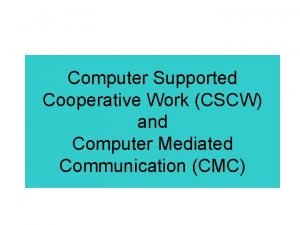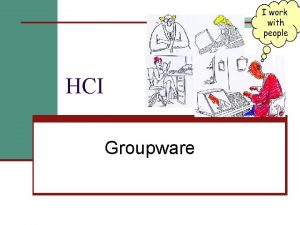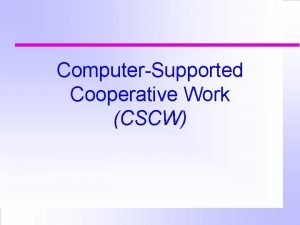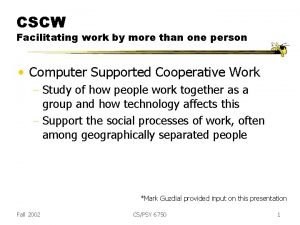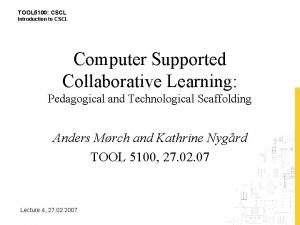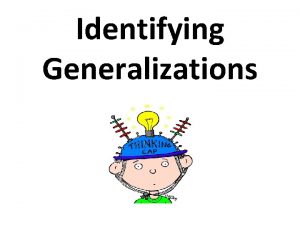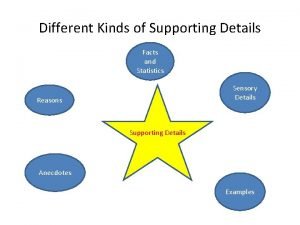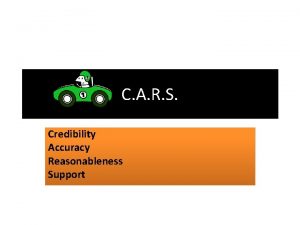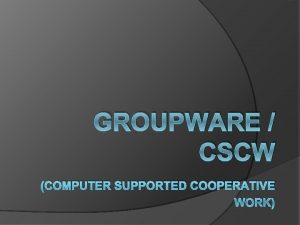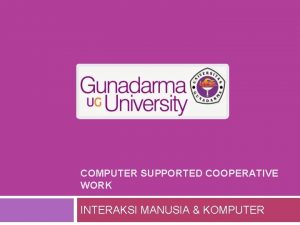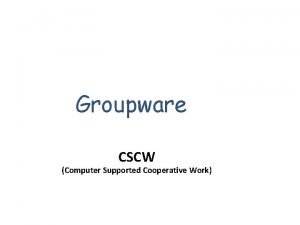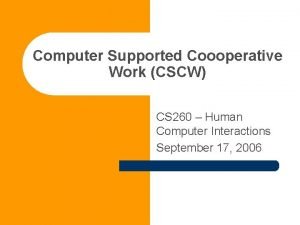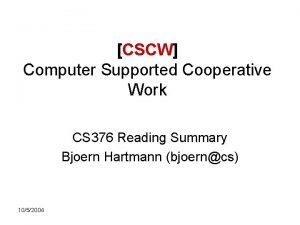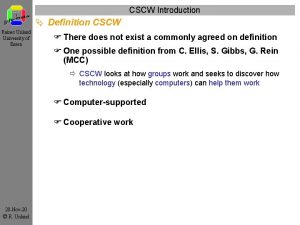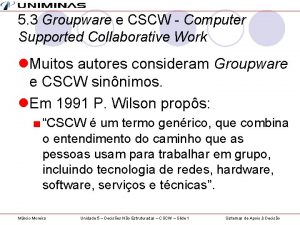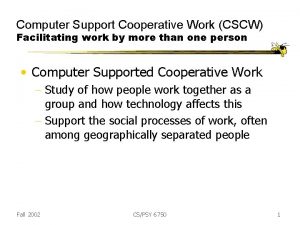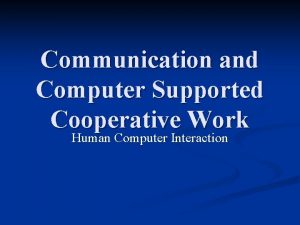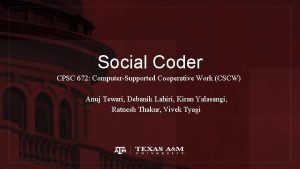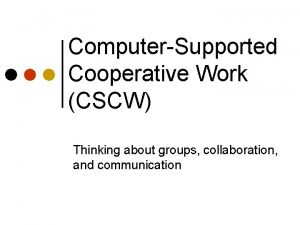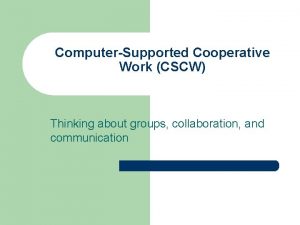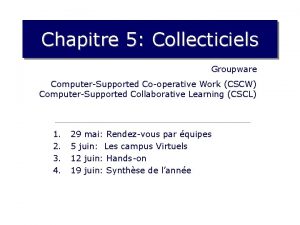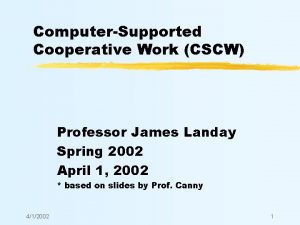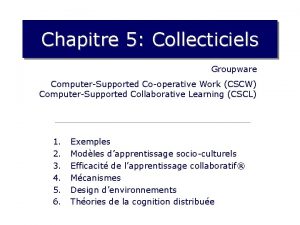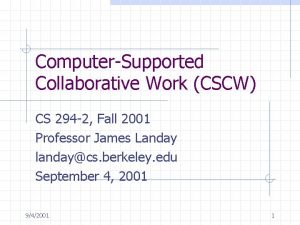CSCW What Is CSCW Computer Supported C Work

























- Slides: 25

CSCW

What Is CSCW? • Computer Supported C----- Work – Cooperative – Collaborative – Competitive • Design and evaluation of new technologies to support social work processes • Fusion of sociology and computing • Creation of groupware systems

CSCW Space-Time Matrix Same Time Different Times Same Place face to face (classes, meetings) asynchronous interaction (post-it notes, Moosburg) Different Places sync distributed (shared editors) asynchronous distributed (email, listservs)

Asynchronous Distributed (Different Time, Different Place) • Email – Delivery occurs in seconds or minutes – Multimedia becoming widespread • Listservs – Leverage email to send to many people • Newsgroups – Alternate forum facilitates longer (threaded) discussions, larger amounts of information

Asynchronous Interaction (Different Time, Same Place) • Computer artifacts – Understand what previous users did or will do – Foster informal discussions via artifacts – Post-it notes, bathroom walls, room schedules – Notification Collage • Place as a metaphor – Create and leverage virtual place much like physical place – Moosburg and other virtual worlds

Notification Collage • Users can post notes and pictures to NC • Information appears on a large-screen display in a shared area • Goal is to foster community and future discussions

Moosburg • Synchronous chat augmented by ability to leave comments • Future visitors can see who has been at a place and what their reactions were

Synchronous Distributed (Same Time, Different Place) • Initial interfaces included telephone and television • Networked computers facilitate distributed applications that update in real-time • Must address issues of ownership and control of information

Shared Editors • Collaboration-aware shared editors • Provide several insertion points • Show who is editing document and where • Include locking protocols or turn-taking

Face To Face (Same Time, Same Place) • Teams often work together using complex shared technology – Pilots, co-pilots – Air traffic controllers – Stock market trading rooms – Offices and classrooms

Group. Systems • Facilitates file sharing, shared workspace, and group activities • Users can submit information, take surveys, or present ideas

Evaluating Groupware • Complexities of human-human communication and group working make evaluation difficult • Finding large numbers of groups is difficult, leading to smaller numbers and less chance for significant results

Experimental Studies • Subject groups – Requires more subjects for longer times – Times and places often difficult to arrange • Experimental task – Decision games test creativity, interaction, structure, leadership (desert survival, diplomacy) • Data gathering – Logging not sufficient as human-human interaction is important – Multiple video shots often used to focus on individuals • Analysis – Anecdotal analysis common (field/ethnographic studies) – Within-subject analysis, microanalysis common

Why Does Groupware Fail? • Disparity between who does work and who gets benefit • Threats to existing power structures • Insufficient critical mass of users • Violation of social taboos • Arguments over measures of success

Why CSCW Applications Fail • Consider group calendar scheduling – What are its advantages? – What are its disadvantages – Who does it support?

Why CSCW Applications Fail • Consider voicemail – What are its advantages? – What are its disadvantages – Who does it support?

Why CSCW Applications Fail • Consider active badges – What are their advantages? – What are their disadvantages? – Who do they support?

Why Does Groupware Fail? • Disparity between who does work and who gets benefit • Threats to existing power structures • Insufficient critical mass of users • Violation of social taboos • Arguments over measures of success

Case Study: Irwin • Monitors Internet resources (email, Usenet news, Web pages, weather) • Uses graphical, textual, and audio communication mechanisms • Effective use of limited screen space

Positives from Irwin • People seem receptive to concept of information awareness devices • Significant variation among users for informational goals and communication mechanisms • Examine the power of a single display mechanism in raising awareness

Case Study: What’s Happening • Goal: promote community awareness and expand social capital with glance-ables • WH communication-bar unobtrusively and calmly sits in a corner cycling through news and chats • Content from: – Users – Calendars – Web pages

WH Lessons • At most 30 users in a community of 300 • Usage required frequent reminders and urging by the developer • Occasional bursts of use followed by extended passive observation • Chatting rare but occasionally animated, typically in response to an article

Case Study: Sideshow • Difficult to keep track of asynchronous, distributed info • Sideshow is “a peripheral awareness interface designed to help users stay aware of people and info” • Design principles – Make it always present – Minimize motion – Make it personal – Make it extensible – Support quick drilldown and escape – Make it scalable (up to dozens of items)

Sideshow Components • Included are: – – – – – • Mouseovers show “tooltip grandes” Meeting timers (large interactive Mailbox updates tooltips) Buddy lists • Tickets on Web pages Video chat lists allow content to be Stock quotes added Bug reports • Internal study: Weather forecast Sideshow distracting Traffic pics/maps but worth it (? ) Ticket button

What Is the Biggest CSCW Success Story? What’s Next? • • • Email Instant messages World Wide Web Mobile telephones Video conferencing Irwin? WH? Sideshow?
 Computer supported collaborative work
Computer supported collaborative work Groupware in hci
Groupware in hci What is cscw
What is cscw Cscw examples
Cscw examples Cscw
Cscw Cscw
Cscw Computer supported collaborative learning
Computer supported collaborative learning Supported scaffold
Supported scaffold Opinion paragraph examples
Opinion paragraph examples Matrix supported conglomerate
Matrix supported conglomerate Bmd and sfd
Bmd and sfd Example of valid generalization
Example of valid generalization Valid generalization examples
Valid generalization examples Sims position nursing
Sims position nursing Supporting facts
Supporting facts What are detrital sedimentary rocks
What are detrital sedimentary rocks Relational-organizational hypothesis
Relational-organizational hypothesis A 125 n object vibrates
A 125 n object vibrates Bio time download
Bio time download Where simply supported beam used
Where simply supported beam used Rayleigh-ritz method cantilever beam example
Rayleigh-ritz method cantilever beam example Prefabricated pontic facings
Prefabricated pontic facings Credibility accuracy reasonableness support
Credibility accuracy reasonableness support Supported employment utdanning
Supported employment utdanning Air supported pneumatic structures
Air supported pneumatic structures Colonial cities functioned primarily as
Colonial cities functioned primarily as
